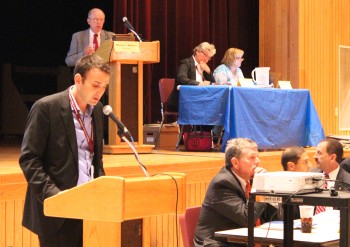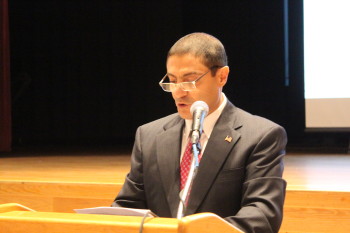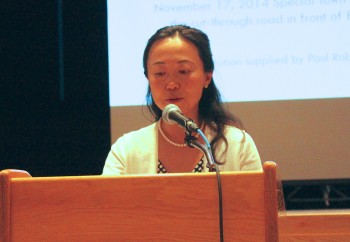[Editor’s note: With the successful citizen’s petition, a Special Town Meeting – the date sometime in June to be determined by the Board of Selectmen on Wednesday, May 4 – will be convened to debate changing the zoning bylaw to require the installation of interior wireless telecommunication antennae to obtain a special permit rather than the current zoning distinction of an “as of right.” This change would specifically place a greater burden on the attempt by Verizon to place a cell antennae inside the steeple of the Plymouth Congregational Church on Pleasant Street. Currently, a significant number of neighbors to the church are protesting the partnership and the communications device. Belmont are two opinions on the matter, both from Pleasant Street.]
Some comments were shortened.
John Beaty
I write to my neighbors, the Plymouth Congregational Church, and the Belmont community after watching and reading our neighborhood protest for almost six months. It is important to me to write a note that all three groups can read.
With a little bit discussion with experts and reading, it is easy to come to the conclusion that cell towers provide less exposure to microwaves than cell phones, about 5 to 10 times less, and the World Health Organization and the American Cancer Society think there is very little evidence to support the idea that living, working, or going to school near a cell phone tower might increase the risk of cancer or other health problems.
But these facts are not relevant, my neighbors are afraid, and do not want any additional microwave exposure. In opposition to my neighbor’s fear and concern are the needs of Plymouth Congregational Church. The Church needs the income from the Verizon cell tower to continue its existence and mission. Neither group has communicated with the other effectively.
It appears to me that the tone of protest has become increasingly acrimonious without cause. The fear, acrimony, and misunderstanding can be reduced by meeting and talking. The time to sit on the sidelines has passed. The Pleasant Street neighborhood and the Plymouth Congregational Church need to put their fears aside, talk with one another and work toward a resolution of the respective issues.
The following note will address four issues in more detail. I am going to start with my understanding of the physics and the health issues, “The Science;” then move on to a discussion of “My Neighbors Are Angry and Afraid;” followed by “The Church Is Stuck;” and lastly present “My Position.”
The Science
My conclusion from the science is that we have little to fear from having a cell phone transmitter in the Church steeple. More importantly, the American Cancer Society also thinks so. There is very little evidence to support the idea that living, working, or going to school near a cell phone tower might increase the risk of cancer or other health problems.
Although the science and rational thinking are important, the facts on the ground are more often governed by feelings and politics, so let’s talk about the Pleasant Street neighborhood and the Plymouth Congregation Church parish.
My Neighbors Are Angry and Afraid
Again, from my point of view, my friends and neighbors are genuinely frightened of the consequences of the exposure to cell tower radiation. The science and rational approach be dammed, this is an unwanted excess exposure and they are afraid of the consequences. The duration and vigor of the neighborhood protest is a testament to the anger and fear.
The protest has been going on for about six months that I know about, but I was told that it started almost a year ago. The neighbors have communicated in many ways. The Pleasant Street residents have:
- Written articles that were printed in the Belmont newspaper about the Church and its intent to host a Verizon cell tower in its steeple.
- Written about the Church parish and its clergy and management.
- Campaigned within the extended Pleasant Street community to consolidate a common position against the Verizon cell tower.
- Posted a Facebook page about the cell tower, church, and potential effects.
- Printed and posted a variety of signs, some printed, some individual handiwork.
- Written and distributed flyers.
It has been a vigorous, vociferous, extended, and sometimes unkind campaign. Yet to my knowledge there has been no direct contact between the Pleasant Street neighbors and the Plymouth Congregational Church (parishioners, managers, or clergy). Neither have I heard, read, or seen the voice of the church community as an advocate for the Verizon cell tower, but they are continuing to move forward with their effort to obtain cell tower approval.
The Church is Stuck
The other half of the equation is the neighborhood Plymouth Congregational Church parish. I do not know, but I think that the parish is in financial decline. It must use its physical plant to keep itself financially viable. Tithing and additional donations from the parishioners is insufficient to keep it in good financial order. So, it rents space for daycare, education, and social events that apparently is not enough. I was told by a parishioner that the parish was approached by Verizon with a cell tower contract offer that would provide an additional revenue stream for the length of the contract. This extra-parochial revenue may or may not be enough to keep the Church in good order, but it would help. I speculate that the contract with Verizon is probably between $2,000 and $3,000 a month for 12 months for 15 years which amounts to more than $360,000. The money from the contract would be available for any parish expense and would probably solve their cash flow issues.
The Church is stuck. It lives in a community that it wants to serve. It has insufficient resources to take care of the Church plant and the activities of the parish. It is trying to do good work; trying to survive: serve it parish, neighborhood and the Belmont community. It is hunkered down, but continuing to move forward toward its objective.
My Position
My neighbors are important to me. As I get older, it is increasingly important to be surrounded by a community of friends and well-meaning neighbors. My spouse and I are acquainted with everyone in the neighborhood and know many of them well enough to call them friends. But we are not afraid of cell phones or cell towers and find ourselves misaligned with the protest and much of the communication.
To add to our misalignment, we know some of the parishioners and have been neighbors with the Plymouth Congregational Church for 30 years. We know about some of the good works the parish has done over those years and view the church as a good neighbor.
The time has come to state my position. I believe in science and public policy based on scientific facts and rational thinking. I believe in direct communication. I believe in civil (sometimes you have to shout to be heard) and respectful discourse. To be more direct: I think the Church and the Pleasant Street neighborhood should talk to one another. The two groups need to figure out a pathway forward with the cell tower.
Glenn Herosian
We all appreciate your desire to promote a resolution of the dispute in our neighborhood. However, your timely commentary reads more like a well-coached spin from a political consultant hired by the church rather than an appeal from a concerned neighbor. Why would you write this sincere appeal to the local press?
Your neighbors are understandably fearful of the ill-defined and involuntary Radiofrequency (RF) radiation about to be thrust into our kitchens, living rooms and bedrooms. But we are far from ignorant about Verizon’s plans for its steeple. Rather, we are outraged by the church’s insensitivity to its neighbors and use of its non-profit status to transform a place of worship into a cell phone tower ”business.” Between congregation donations, probable Community Preservation Act funding, and current monthly rents from numerous tenants, the church’s financial needs could be satisfied without creating controversy and discord in its own neighborhood.
Unfortunately, we continue to see mischief from Verizon as it submits misleading applications and times its actions to avoid public discussion.
Your treatise on “the Science” mentions the appropriate RF formulas but also echoes the inaccurate mantra of the church that our occasional use of cell phones is more harmful than the continuous exposure from high powered antennas. Your example underestimates the impact of these antennas as well as the actual duration and cumulative effect on those 23 families within the red zone. The one key difference between a cell phone and base station emissions is that we can all turn off our cell phones to limit our exposure. We do not have that option to control the output of a continuously-radiating cluster of antennas hidden less than 100 feet from our childrens’ bedrooms.
Despite your assurances, parents of children in the neighborhood take a precautionary approach to the radiation emitting from the cell phone antennas much as they would with any other danger to their children. Not one of the church’s congregation lives within the high exposure range of the Plymouth Church’s antennas.
On January 15, eight of us stood outside the church and politely shared information about the availability of CPA funds and our willingness to work with the church. I do not believe that the church is “stuck,” nor would I generalize without facts about its financial condition. The church has some prominent members who could have guided their congregation toward CPA funding to preserve its building, leaving its other income to support its ministry. Unfortunately, church leaders have demonstrated little interest in CPA funds or restoring harmony in the neighborhood.
Let’s remember to consider the financial impact on the town. With Belmont financially “stuck’ by the long term funding for a new high school and library, putting the cell tower on town property and receiving Verizon’s monthly cell tower fee would help a far greater number of Belmont citizens than just those attending the church. Cell phone base stations also devalue neighboring property. The combined property devaluation and loss in real estate tax revenue could total millions and hurt the town even more.
Our group’s position is that the church should continue doing its “good work” and be a place of worship rather than becoming a cell phone business that disregards the legitimate concerns of the families living around it. We understand the “science” of our cell phones, but cannot blindly trust incomplete scientific research distorted by powerful cell phone lobbies. The win-win solution is for the Church to obtain CPA funds and Verizon to locate the antennas in a less-dense residential area to help restore harmony to our neighborhood.




